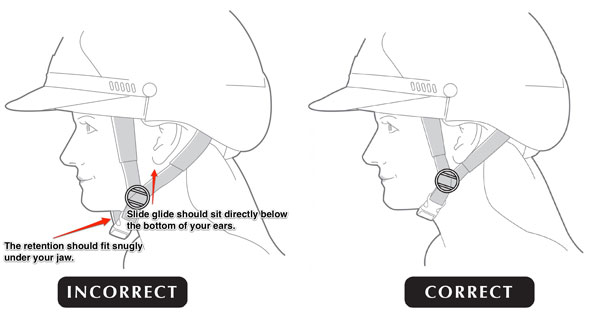Helmet Safety & Legal Liability
Riding Helmet Safety & Legal Liability Guide
By: Allen Financial Insurance Group
Contact us for more helmet safety information or any other legal liability questions.
Helmet Safety
Unless you’ve been marooned on a desert island for the past two decades, you are probably aware that ASTM/SEI certified riding helmets can help prevent head injuries. Nevertheless, many equestrians choose not to wear helmets, for a variety of reasons, mostly related to tradition, fashion and comfort. As a result, we receive a lot of questions about helmet-related liability.
Wearing a helmet reduces the risk of serious head and brain injury by 85%. Helmets should be worn during every ride, no matter how short. Many accidents happen near home.

Helmet Safety and Legal Liability
A question which always needs to be addressed is whether a rider is going to wear a safety approved helmet each and every time they ride. If you have anything to do with the horse or the property where the horse will be ridden, you need to make sure either the rider wears a safety approved helmet or the rider signs a release specifically regarding helmets. (Of course a guardian should sign the release for minor children.) Even if you do not personally believe in helmets, if there is an accident, your liability and the costs for the injury are greatly affected by how you address the issue of helmets.
If you did not get a release or if you get a release in an area where helmets are required, and there is no helmet worn, you can count on the issue being used against you if there is a lawsuit from an injury. (On January 27, 1999, Plantation, Florida became the first city in the United States to make the use of approved helmets for children riding horses on public property. California has considered a bill doing the same, but it has not yet passed.) You may be responsible for the fact that there was no helmet worn. At least if you have a release, the rider can be considered to have assumed the risk. Based on the trend in the courts and the willingness of the legislatures to enact laws requiring helmets, we strongly recommend you consider requiring safety approved helmets and wearing them yourselves.
The facts supporting the use of helmets are too substantial to be ignored. We are ASTM (American Society for Testing Materials) SEI approved helmet proponents from both legal and practical standpoints. If you value your life and the lives of your friends and family, you too should be a helmet proponent. Not only can it save a life, but it can prevent epilepsy, personality changes, intellectual and memory impairment, and other results of brain injury.
The excuses for not wearing an approved helmet range from “they don’t look good” and “they’re uncomfortable”, to, “they do nothing for head protection”. Think about your responses to those reasons after you consider the following facts:
Riding a bicycle is considered less dangerous than riding a horse. On April 19, 1999, the Minneapolis Star and Tribune published the following facts:
- Of the bicyclists killed in 1997, 97 percent weren’t wearing helmets.
- Bicycle helmets have been shown to reduce the risk of head injury by as much as 85 percent and the risk of brain injury by as much as 88 percent.
- Bicyclists admitted to hospitals with head injuries are 20 times more likely to die than those with other injuries.
- An estimated 75 percent of bicycle-related deaths among children could be prevented with the wearing of a bicycle helmet. Universal use in this country of bicycle helmets by children ages 4-15 could prevent 135 to 155 deaths, 39,000 to 45,000 head injuries and 18,000 to 55,000 scalp and facial accidents annually.
Legal Liability & Helmet Safety
Are you Convinced YET? Read on…
According to the BCMA’s Council on Health Promotion (British of Columbia’s Medical Association, athletes involved in horse riding are more likely to suffer head trauma than those involved in football, boxing or soccer. Head injuries are the most common reason for admission to hospital or even death among riders. Most injuries occur during pleasure riding.
The BCMA has published the following facts:
- A fall from 2 feet can cause permanent brain damage. A horse elevates a rider 8 feet or more above ground.
- A human skull can be shattered by an impact of 7-10 kph. Horses can gallop at 65 kph. Children’s skulls are most vulnerable.
- Ages ten to fourteen, are the children most likely to be involved in an accident with a horse but all ages are at risk.
- A rider who has one head injury has a 40% chance of suffering a second head injury. Children, teens and young adults are most vulnerable to sudden death from second impact syndrome. Second impact syndrome is the severe swelling of the brain caused by a second head injury before recovery from the first head injury.
- Racing organizations require helmets and as a result jockeys now suffer less head injuries than pleasure riders.
- The U.S. Pony Club lowered their head injury rate 29% with mandatory helmet use.
- Britain’s hospital admission rate for equestrians fell 46% after helmet design improved and they became in routine use.
If you think you are protecting yourself with a non-approved helmet, consider the warning on them:
[These helmets] are items of apparel only. They are not in any sense protective headgear. They have not been designed, manufactured, or tested by us, and will afford no protection to the wearer against injury to the head resulting from a fall from a horse or other source of impact.
SEI (Safety Equipment Institute)ASTM approved helmets work if they fit correctly and have the chin strap firmly applied. Other types of helmets, including bike helmets, are inadequate.
Even with a safety approved helmet, there is no guarantee that death or brain injury will not occur, however, there is a strong probability that the injury will be less or nonexistent and isn’t that worth a little discomfort or “hat hair”?
Bloomquist & Halper, P.A. is a law firm with a focus on equine law. Barbara A. Halper and Katherine C. Bloomquist are the partners in the firm. They both are active in the equine community. They focus on preventing legal issues as well as litigating lawsuits for their clients.
What is ASTM/SEI?
All helmets not manufactured to ASTM/SEI standards carry a label or insert stating that the helmet is an item of apparel only and will provide no protection to the wearer from a fall or impact.
The ASTM (American Society for Testing and Materials) is an organization comprised of thousands of skilled volunteers including doctors, engineers and physicists. It is the job of the ASTM to set standards for many types of safety equipment. The ASTM has created criteria for horseback riding helmets to adhere to. These standards are summarized in ASTM F 1163. The SEI (Safety Equipment Institute) is an independent laboratory that tests helmets to be sure they meet the ASTM standard.
Why Do We Need a Standard?
In 1980 the United States Pony Club began tracking accidents reported among its members. Three years later, the Pony Club developed its own standard for riding helmets and required that all members wear their USPC standard helmets which had been tested at independent laboratories. In 1986 the USPC asked ASTM, an organization that had developed helmets for other sports to develop one for horseback riding helmets as well. ASTM F 1163 was first published in 1990 and is reviewed every five years.
The study the Pony Club began in 1980 continued for 12 years and provided arresting evidence in favor of the standard. The USPC found a 26% decrease in head injuries with the onset of the USPC standard helmet in 1983. Although there have been no official studies completed for the ASTM standard, the American Medical Equestrian Association estimates that ASTM/SEI approved helmets have decreased riding-related head injuries by 50%.
How to Distinguish Between Approved and Unapproved Helmets
The easiest thing to look for is the ASTM/SEI seal inside the helmet. If you are skeptical however, approved helmets have a thicker shell. Look at the helmets from below and you should be able to see the difference in thickness. Approved helmets cannot have a simple snap to secure the harness. Snaps are not used because they are prone to popping open upon impact. You can also look at the harness. There is no such thing as an approved helmet with a completely clear harness.
Helmet Fitting and Replacement
Here are some guidelines you can use to decide whether or not your helmet fits properly:
- When you wiggle your helmet it should move your eyebrows – this is one way to know that it fits tight enough. Only you can tell if the helmet feels too tight.
- The helmet should stay comfortably on your head when harnessed without moving around on your head no matter what you’re doing. When trying on a helmet in the store, bend over at the waist and shake your head. A correctly fitted helmet will not move.
- After wearing the helmet for about 5 minutes, remove it and check for marks on your forehead. Indentations in your forehead left from the helmet may indicate you should try one size larger.
- Be sure to use the foam spacers that come with your helmet. These will help you get the best fit out of your helmet.
- Long hair should be secured below your helmet so as not to interfere with fitting.
- A helmet should fit equally all the way around the head without exposing the forehead or obscuring vision.
- When you open your mouth wide with the harness fastened, you should be able to feel pressure on your throat –not the tip of your chin. This will ensure stability of the helmet.
Signs That May Indicate Your Helmet is Too Big:
- Helmet wiggles when you move your head from side to side or back and forth.
- Your eyebrows do not move when you wiggle the helmet with your hand.
- The helmet obscures your vision.
Signs That May Indicate Your Helmet is Too Small:
- The helmet leaves a line on your forehead when you take it off.
- Wearing the helmet for more than a few minutes gives you a headache.
- The helmet is sitting up too high on the top of your head, leaving most of your forehead exposed.


